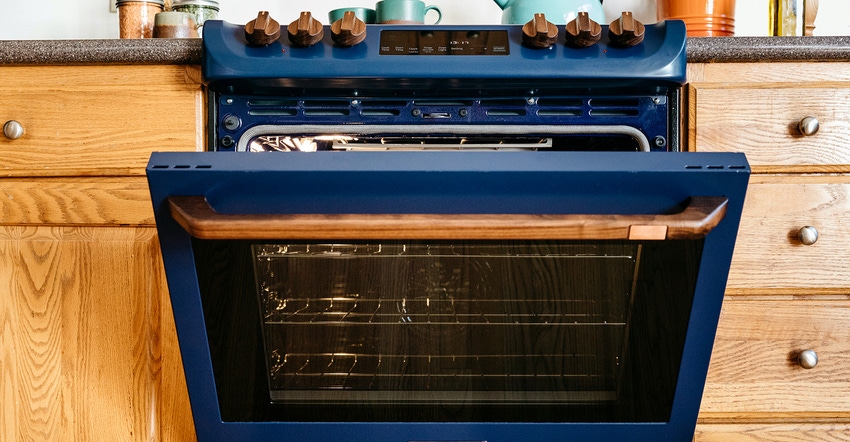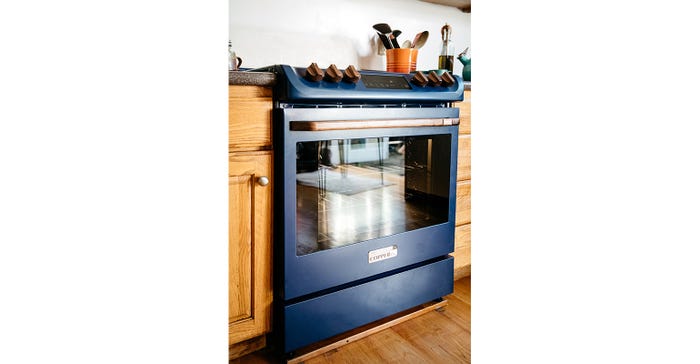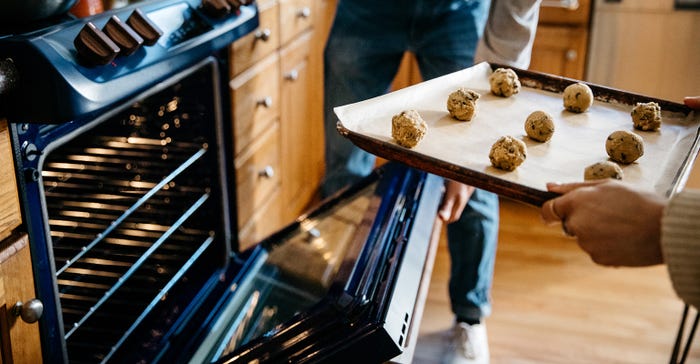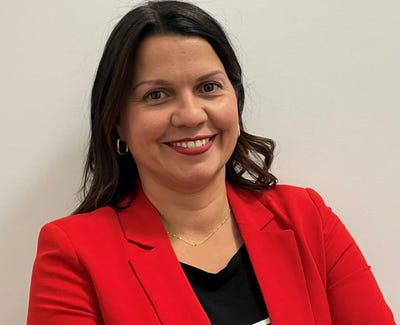Why a Battery-Assisted Induction Stove Makes Sense
Startup Channing Street Copper’s innovation spares users the need to upgrade their home's electrical system—while moving them to clean energy. Chief Scientist Sam Calisch explains.

The induction stove, which uses magnetic fields to precisely and quicky cook foods, has been gaining interest in the US as fears of cooking with natural gas have mounted. In fact, it was just announced that New York has officially become the first US state to ban gas stoves from new residential buildings. One barrier to their widespread adoption, however, has been that they require a 220-volt electrical hookup, which means for most buyers the cost of an electrical panel upgrade on top of the price of the stove itself. But now a startup called Channing Street Copper Company has created a battery-assisted induction stove that can be plugged into a standard 120V outlet. Battery Technology had the opportunity to interview Channing Copper Chief Scientist Sam Calisch about the company’s first product, the company’s vision, the potential of battery energy storage appliances, and more.
Can you introduce yourself and tell us about what inspired the creation of the Channing Street Copper Company?
Calisch: I work in the electrification space, which is trying to figure out the right regulatory changes, policy changes, and the right technologies that can help us move from fossil fuels to electric appliances, and that's everything from furnaces to heat pumps, to electric water heaters, to electric vehicles, and electric stoves.
We need to install many batteries in our world, enabling us to use clean electricity like wind and solar. We have seen in the battery market this amazing cost reduction in the price of batteries, down $150 per kWh. If you look at the cost to install a battery at your house, like a Tesla Powerwall or an LG battery, the cost is about ten times higher. It's close to $1015 kWh. That extra cost comes from all the custom electrical work, all the custom inspections, and permitting that needs to happen to do that today.
When we started Channing Copper, we said: “What if instead of putting a battery in a custom way, we'll just put it into an appliance in a factory as safely and cheaply as possible? And then we'll bring that appliance into a home via the usual sales channels?” And in that way, that's how we'll get batteries into people's homes to support clean electricity as quickly and cheaply as possible.
Why did the Channing Copper start with an induction stove?
Calisch: We said: “Okay, we’re going to put batteries into appliances, but what appliance?” Then we decided the value we would give to our customers. We did many customer interviews, talked to people, and found that many people were switching from gas cooking to induction cooking for many reasons. People might be switching because of environmental concerns, or they might have read about research about the harmful health effects of gas stoves and the link between gas stoves and asthma/dementia. They wanted to switch to electric stoves, but most of them would have to rewire their houses. And while that should be simple, it is often not—and can be pretty expensive.
A conventional induction stove requires a 50-amp breaker. People would have to run a new high-capacity outlet to their kitchen: a 50A-240V outlet. As soon as you’re running that wire, you’re peeking behind the drywall, maybe you’ve got some lead paint, and then you need to do lead paint remediation. Or perhaps you don’t even have enough electrical service. The amps in your breaker box aren’t big enough to support the added load of a stove. Also, if you have an electric vehicle charger, you might not have enough to add the induction stove. Therefore, the cost of all the electrical upgrades the people were doing was more than the cost of getting that new stove.
And so instead, we said: “Well, if we put a battery in the stove, then we can make it so that it just plugs into the existing outlet because the battery can give that high-power output.” When you want to boil the water quickly, or you’re preheating the oven, it can be recharged slowly from the existing outlet behind a cooking gas stove.

How long does the charge of the battery last? What are the battery specifications?
The battery is a 4.6kWh Lithium Iron Phosphate battery (LiFePO4). But what it’s interesting is that the battery supplies that burst of energy when you’re bringing the water to a boil, but when you’re making dinner, you only need that for five minutes. And then, as soon as the water is at a boil, the amount of power required is much lower. In essence, the battery will run forever under normal circumstances because it’s constantly being replenished from the 110V 15A outlet.
Would the battery be charging constantly?
Calisch: That’s one way to use this induction stove. The battery can charge until it’s full and then stop charging, and then as soon as you turn on the stove, you start charging again. But if you want to, you can also effectively run the induction stove in a way that helps support the grid or help support clean energy.
For example, the battery can be set only to charge during the day when there’s cheap solar energy on the grid. And then, during dinner time, when there’s less solar energy because the sun has gone down, the battery doesn’t charge and waits until the next day to charge back up power.
How does Channing Copper ensure the safety and reliability of these batteries?
Calisch: We take safety seriously. As I said, we use an LFP battery. And so, relative to NMC, this is a much safer chemistry. So right out of the gate, we chose LFP batteries because this is a much safer chemistry, especially for thermal issues. As a bonus, there's no cobalt in the battery, which is one of the critical minerals that is most constrained.
The battery has temperature monitoring systems if anything ever gets too hot. Like the stove, it protects itself and it's safe. Older ovens have a heating element on the bottom of the oven while a modern convection oven uses a heating element in the back. And so, a modern convection oven, the very bottom of the oven doesn’t get that hot on the outside.
After lots of tests simulating worst-case conditions, we decided to place the battery down at the bottom, underneath the oven, where the battery temperature effectively never rises above room temperature. The battery is all built-in and all pre-wired in the factory. So, in your home, they just put the stove there, and nothing else has to happen.
We work with battery manufacturers who have stringent safety testing procedures. We use the industry best safety testing. And we intentionally selected a battery manufacturer with a good track record here.

Can you charge other kitchen appliances with the battery from the induction stove?
Calisch: Yes. It has an auxiliary outlet on the back. You can use it in a couple of ways: If the power goes out, you can plug other things into that to run your fridge on the stove. But you can also, for instance, keep the fridge plugged in all the time. And then, you can effectively use the battery to manage more loads.
What has been the public’s reaction to this product?
Calisch: It's been very, very positive. So far, many people want to get rid of their gas stoves, but they can't because of the complexity of their electric home's electrical system. Those people have started showing up in our shop. It is always fun when we wheel the stove to a farmers’ market or community festival and cook stuff for people to educate them about induction. That's a fun way to get out and tell people about Channing Copper.
Are these inductive stoves in the market already? Are you selling them now?
Calisch: Yes, we did a pre-order of stoves that we sold out. We have a long waitlist now. And we are working with channel partners who will be selling our product through other channel partners as well. We are currently scaling our production up to meet the demand.
What is the company’s vision for the future of energy storage in home appliances?
Calisch: The induction stove is one of many appliances facing the challenge of upgrading electrical systems. Water heaters are another example, clothes dryers too. Our vision is to scale to offer a suite of appliances that all use this battery to help make it easier to electrify your home.
In addition, there's a real potential that once you have installed all these batteries, you can use them to help support the grid. As we electrify, we must ensure we use batteries to support the grid operation. And so, if you have many appliances that can shift their loads, they become a helpful tool. Long term, that's in the company's vision.
We are starting with the induction stove because it's an emotional object. You know, you cook dinner around it, you gather around it. We can make an excellent product and get people excited about it. That's less true about a water heater. No one gathers around their water heater usually. We hope that we first sell a customer a stove, which works very well, and then when their gas water heater breaks and they're facing some of these challenges mentioned before, they say: “ Well, let's get the Copper water heater too.”
About the Author(s)
You May Also Like





